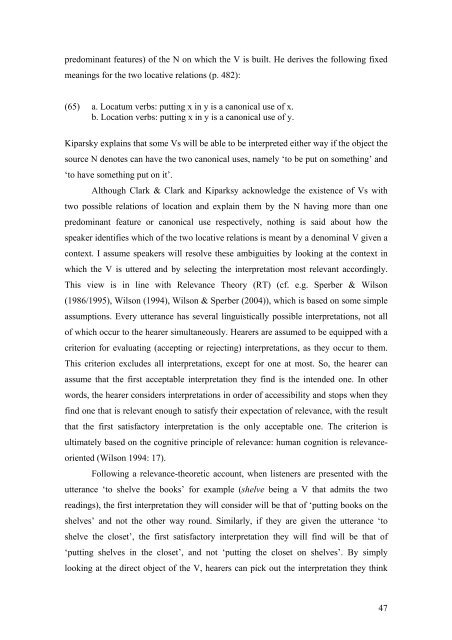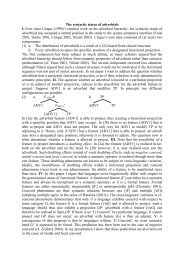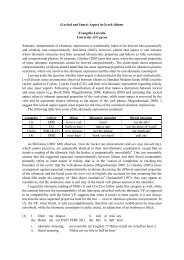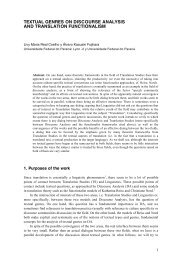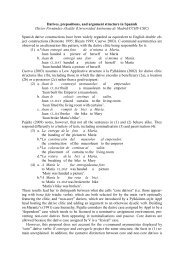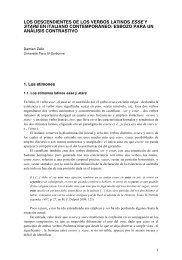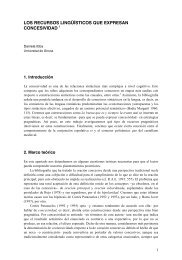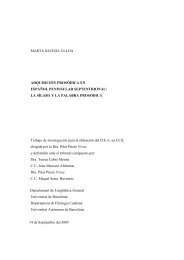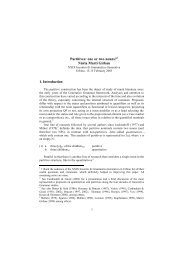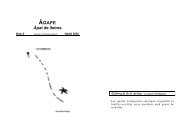Prefixation in English and Catalan - Departament de Filologia ...
Prefixation in English and Catalan - Departament de Filologia ...
Prefixation in English and Catalan - Departament de Filologia ...
You also want an ePaper? Increase the reach of your titles
YUMPU automatically turns print PDFs into web optimized ePapers that Google loves.
predom<strong>in</strong>ant features) of the N on which the V is built. He <strong>de</strong>rives the follow<strong>in</strong>g fixed<br />
mean<strong>in</strong>gs for the two locative relations (p. 482):<br />
(65) a. Locatum verbs: putt<strong>in</strong>g x <strong>in</strong> y is a canonical use of x.<br />
b. Location verbs: putt<strong>in</strong>g x <strong>in</strong> y is a canonical use of y.<br />
Kiparsky expla<strong>in</strong>s that some Vs will be able to be <strong>in</strong>terpreted either way if the object the<br />
source N <strong>de</strong>notes can have the two canonical uses, namely ‘to be put on someth<strong>in</strong>g’ <strong>and</strong><br />
‘to have someth<strong>in</strong>g put on it’.<br />
Although Clark & Clark <strong>and</strong> Kiparksy acknowledge the existence of Vs with<br />
two possible relations of location <strong>and</strong> expla<strong>in</strong> them by the N hav<strong>in</strong>g more than one<br />
predom<strong>in</strong>ant feature or canonical use respectively, noth<strong>in</strong>g is said about how the<br />
speaker i<strong>de</strong>ntifies which of the two locative relations is meant by a <strong>de</strong>nom<strong>in</strong>al V given a<br />
context. I assume speakers will resolve these ambiguities by look<strong>in</strong>g at the context <strong>in</strong><br />
which the V is uttered <strong>and</strong> by select<strong>in</strong>g the <strong>in</strong>terpretation most relevant accord<strong>in</strong>gly.<br />
This view is <strong>in</strong> l<strong>in</strong>e with Relevance Theory (RT) (cf. e.g. Sperber & Wilson<br />
(1986/1995), Wilson (1994), Wilson & Sperber (2004)), which is based on some simple<br />
assumptions. Every utterance has several l<strong>in</strong>guistically possible <strong>in</strong>terpretations, not all<br />
of which occur to the hearer simultaneously. Hearers are assumed to be equipped with a<br />
criterion for evaluat<strong>in</strong>g (accept<strong>in</strong>g or reject<strong>in</strong>g) <strong>in</strong>terpretations, as they occur to them.<br />
This criterion exclu<strong>de</strong>s all <strong>in</strong>terpretations, except for one at most. So, the hearer can<br />
assume that the first acceptable <strong>in</strong>terpretation they f<strong>in</strong>d is the <strong>in</strong>ten<strong>de</strong>d one. In other<br />
words, the hearer consi<strong>de</strong>rs <strong>in</strong>terpretations <strong>in</strong> or<strong>de</strong>r of accessibility <strong>and</strong> stops when they<br />
f<strong>in</strong>d one that is relevant enough to satisfy their expectation of relevance, with the result<br />
that the first satisfactory <strong>in</strong>terpretation is the only acceptable one. The criterion is<br />
ultimately based on the cognitive pr<strong>in</strong>ciple of relevance: human cognition is relevanceoriented<br />
(Wilson 1994: 17).<br />
Follow<strong>in</strong>g a relevance-theoretic account, when listeners are presented with the<br />
utterance ‘to shelve the books’ for example (shelve be<strong>in</strong>g a V that admits the two<br />
read<strong>in</strong>gs), the first <strong>in</strong>terpretation they will consi<strong>de</strong>r will be that of ‘putt<strong>in</strong>g books on the<br />
shelves’ <strong>and</strong> not the other way round. Similarly, if they are given the utterance ‘to<br />
shelve the closet’, the first satisfactory <strong>in</strong>terpretation they will f<strong>in</strong>d will be that of<br />
‘putt<strong>in</strong>g shelves <strong>in</strong> the closet’, <strong>and</strong> not ‘putt<strong>in</strong>g the closet on shelves’. By simply<br />
look<strong>in</strong>g at the direct object of the V, hearers can pick out the <strong>in</strong>terpretation they th<strong>in</strong>k<br />
47


